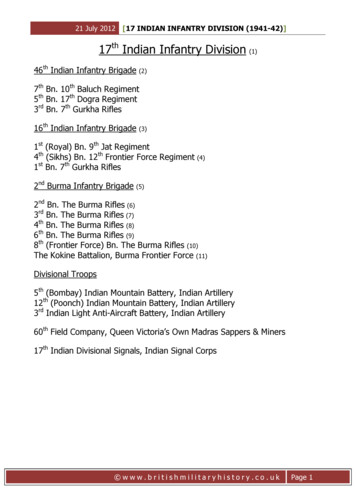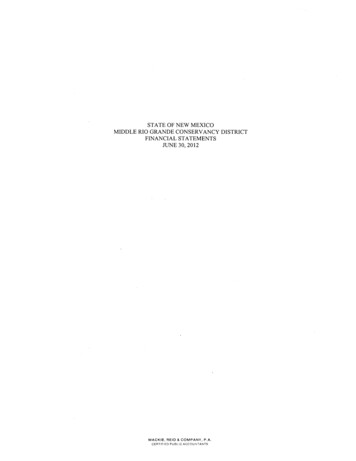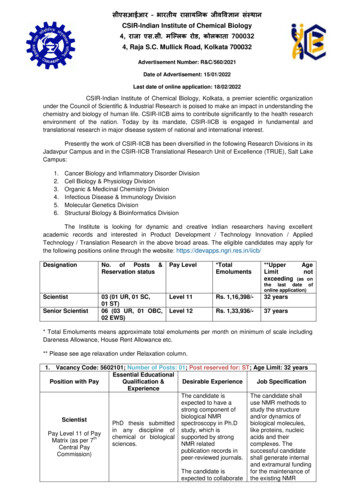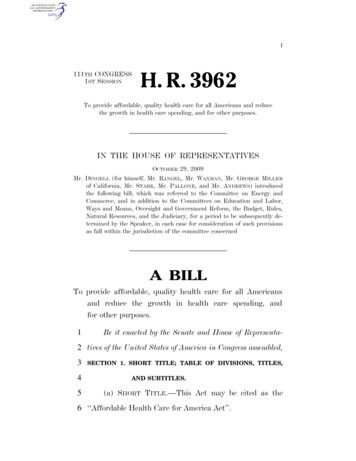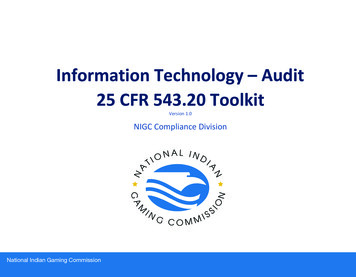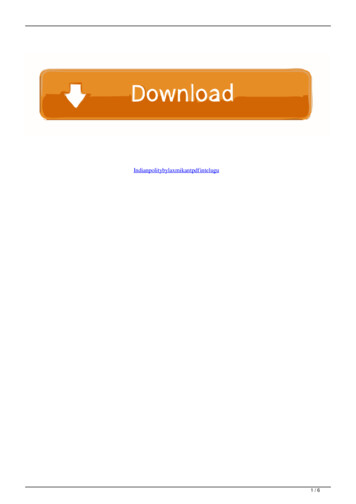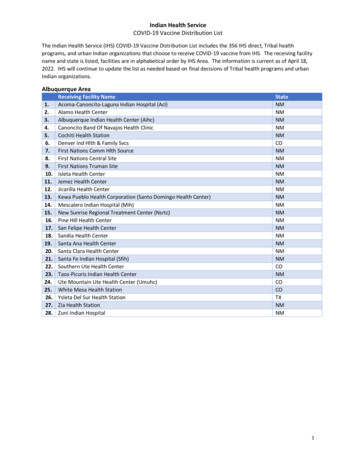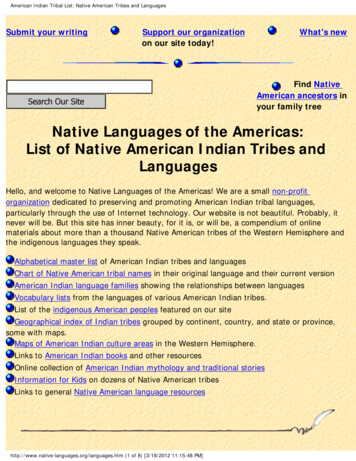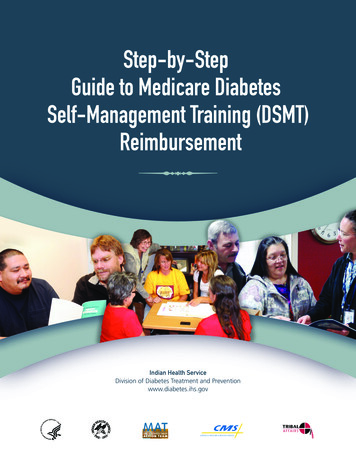
Transcription
Indian Health ServiceDivision of Diabetes Treatment and Preventionwww.diabetes.ihs.gov
Writing TeamWriting TeamCAPT Tammy L. Brown, MPH, RD, BC-ADM, CDENutrition Consultant, IHS Division of Diabetes Treatment and PreventionJohnnie Brasuell, APRN, MCNDiabetes Program Director, Muscogee (Creek) NationRobin Thompson, MS, APRN, BC-ADM, CDENurse Consultant (contract), IHS Division of Diabetes Treatment and PreventionCDR Adam T. Archuleta, MPHDirector, Revenue Enhancement Services, IHS Tucson AreaLCDR John E. Rael, MBA, BBAManagement and Program Analyst, IHS Office of Resource Access and Partnerships, Division ofBusiness Office EnhancementIndian Health ServiceDivision of Diabetes Treatment and PreventionOctober 2011www.diabetes.ihs.govStep-by-Step Guide to Medicare Diabetes Self-Management Training Reimbursementi
Table of ContentsTable of ContentsForeword.vIntroduction.viFrequently Used Abbreviations .viiiSection One: Ready Set Diabetes Self-Management Training!An Overview of Medicare Diabetes Self-Management TrainingReimbursement.9What is the Medicare Diabetes Self-Management Training (DSMT) benefit?.10What is the Medicare Medical Nutrition Therapy (MNT) Benefit?.12How does Medicare Reimburse for DSMT Services in I/T/U Facilities?.14What is the Medicare Telehealth DSMT Benefit?.16What about Reimbursement for DSMT Services from Other Health Insurance Plans?.17Section Two: Let’s Get Started Go!7 Steps for Diabetes Self-Management Training Reimbursement.18Step 1: Become an Accredited Diabetes Self-Management Training Program.19Step 2: Make Friends with Your Business Office .20Step 3: Obtain Treating Physician or Qualified Non-physician PractitionerReferral and Authorization for Patient Visit .22Step 4: Learn about Procedural (HCPCS) Codes andDiagnosis (ICD-9) Codes for Reimbursement .23Step 5: Document DSMT Services .24Step 6: Track DSMT Services and Reimbursement .25Step 7: Market DSMT Services and Proactively Seek Reimbursement .27Step-by-Step Guide to Medicare Diabetes Self-Management Training Reimbursementiii
Table of ContentsSection Three: Resource Materials .29Appendix A: Summary Chart on IHS Medicare Part A and B Coverage and Billing Requirementsfor MNT and DSMT .30Appendix B: Overview of AADE and ADA Accreditation Process .39Appendix C: Diabetes Services Paper Order Form .41Appendix D: IHS EHR Diabetes Services Referral Form .42Appendix E: Sample DSMT Super-bill in EHR .43Appendix F: CMS Form UB-04 (CMS Form 1450) .44Appendix G: CMS Form 1500 “Health Insurance Claim Form” .45Appendix H: IHS EHR Template for Documenting Patient’s DSMT Goals .46Appendix I: IHS EHR Diabetes Services (DSMT and MNT) Order Form .49Appendix J: Sample DSMT Reimbursement Tracking Form .52Appendix K: Top Documentation Errors to Avoid in Applying for DSMT Reimbursement .53Appendix L: Additional Resources.54Appendix M: Glossary .56Appendix N: References .60Acknowledgements .62ivStep-by-Step Guide to Medicare Diabetes Self-Management Training Reimbursement
ForewordForewordThe Step-by-Step Guide to Medicare DSMT Reimbursement providesIHS staff with the information needed to obtain prompt Medicarereimbursement for Diabetes Self-Management Training (DSMT)services. The guide clearly and concisely illustrates seven steps frombecoming a Medicare-recognized diabetes education program tomarketing DSMT services. It also includes useful resources for puttingthese steps into practice.Congress authorized the DSMT benefit for eligible Medicarebeneficiaries based on research findings demonstrating itseffectiveness. Programs providing DSMT significantly improve apatient’s access to quality care and can help improve outcomes—apriority of the Indian Health Service (IHS). At the same time, Medicare reimbursement (and otherthird-party payers) for DSMT represent a new revenue stream for the Indian health care system.Self-management is essential to diabetes treatment and leads to accomplishing successfuloutcomes. DSMT programs teach essential skills needed by people with diabetes, such asbalancing nutrition and physical activity, maintaining glycemic control, and how to perform selfcaretasks, such as blood glucose monitoring and insulin administration.DSMT is an ongoing, interactive, and collaborative process, which involves the person withdiabetes and a diabetes educator. DSMT goals are to optimize glucose control, improve oroptimize quality of life, and prevent acute and chronic diabetes-related complications.I encourage you to use this information to improve the quality of diabetes care, strengthenadministrative efficiency and maximize reimbursements at your health facility.Finally, I want to thank all of the IHS, Tribal, and Urban Indian health staff and the Centers forMedicare & Medicaid Services personnel who contributed their knowledge and experience to thisimportant publication./Yvette Roubideaux/Yvette Roubideaux, M.D., M.P.H.Director, Indian Health ServiceStep-by-Step Guide to Medicare Diabetes Self-Management Training Reimbursementv
IntroductionIntroductionDiabetes self-managementtraining (DSMT)* is an essentialpart of diabetes care. DSMTservices provide people withdiabetes with the knowledge,skills, and ability to performdiabetes self-care tasks. Theprocess involves informeddecision-making, problemsolving, and collaboration withthe health care team to improveclinical outcomes, health status,and quality of life for peoplewith diabetes. The diabeteseducator works closely with thepatient to provide DSMT services.(L to R): Jackie McKnight, patient consumer; Joyce Hansen, RN, Diabetes Nurse Educator,Claremore Diabetes Education Program, Oklahoma; Dianna Garman, patient consumer;Christy Heape, patient consumer. Hypertension Class at Claremore Indian Hospital,Claremore, OK.Section 4105 of the BalancedBudget Act of 1997 permittedthe Centers for Medicare andMedicaid Services (CMS) toreimburse health care facilities and organizations for DSMT services when provided to qualifiedMedicare beneficiaries by an accredited, quality education program. The National Standards forDiabetes Self-Management Education (NSDSME) are the framework designed to define qualitydiabetes education and to assist diabetes educators in a variety of settings in providing evidencedbased education.Currently, CMS recognizes two national accreditation organizations (NAOs) that follow the guidelinesidentified in the NSDSME and that have established processes for recognizing quality DSMT services.They are: the American Association of Diabetes Educators (AADE) Diabetes Education AccreditationProgram and the American Diabetes Association (ADA) Education Recognition Program.As of February 2011, the IHS Division of Diabetes Treatment and Prevention (DDTP) is no longer aNAO for DSMT services. Instead, the DDTP will continue to support IHS, Tribal, and Urban programsinterested in becoming an accredited DSME program by providing training, technical assistance,educational materials, and other resources.* DSMT is also known as DSME, or diabetes self-management education. Although DSME is the preferred term, the CMS requires the useof DSMT in reimbursement documentation. Therefore, “DSMT” is used throughout this guide.viStep-by-Step Guide to Medicare Diabetes Self-Management Training Reimbursement
OverviewOverview of the Guide to MedicareDSMT ReimbursementThe guide is designed for Indian health system: accredited diabetes self-management training program teams diabetes self-management training programs seeking accreditation and business office teams.The purpose of the guide is to help you: document accredited DSMT services and outcomes work with your health care facility to bill for DSMT services take an active role in seeking DSMT reimbursement and market your services within the Indian health care system and to your Tribal members.The guide is divided into three major sections: The DSMT Reimbursement Overview introduces you to the Medicare guidelines for DSMTreimbursement. The 7 Steps to DSMT Reimbursement takes you through each step of the DSMTreimbursement process. The Resource Materials in the appendices provide sample referral, reimbursement andtracking forms, sample electronic health record (EHR) templates, additional informationresources, a glossary, and references.Take Advantage of this Opportunity for ReimbursementMany Indian health staff members have shared tips and ideas to help create this comprehensive,step-by-step guide. Opportunities to be reimbursed for your services are waiting for you. Takeadvantage of them! Embrace them! Just do it!Step-by-Step Guide to Medicare Diabetes Self-Management Training Reimbursementvii
Frequently Used AbbreviationsFrequently Used AbbreviationsAADE. American Association of Diabetes EducatorsABN . Advanced Beneficiary NoticeADA . American Diabetes AssociationAI/AN. American Indian and Alaska NativeAIR .All-Inclusive RateCAC .Clinical Application CoordinatorCAHs . Critical Access HospitalsCDE .Certified Diabetes EducatorCMS . Centers for Medicare and Medicaid ServicesCPT.Current Procedural Terminology or Common Procedural TerminologyDDTP . Division of Diabetes Treatment and PreventionDME . Durable Medical EquipmentDSME* .Diabetes Self-Management EducationDSMT* .Diabetes Self-Management TrainingEHR . Electronic Health RecordFQHC.Federally Qualified Health CentersHCPCS .Healthcare Common Procedure Coding SystemHIT. Health Information TechnologyICD-9 .International Classification of Diseases, 9th RevisionIDERP . IHS Integrated Diabetes Education Recognition ProgramIDNT . International Dietetics and Nutrition TerminologyIHS.Indian Health ServiceKDE .Kidney Disease EducationMAC.Medicare Administrative ContractorMNT .Medical Nutrition TherapyNAO .National Accrediting OrganizationNPI.National Provider IdentifierNSDSME . National Standards for Diabetes Self-Management EducationOMB .Office of Management and BudgetPCC . Patient Care ComponentPFE . Patient and Family Education ProtocolsPOC .Plan of CareQNPP . Qualified Non-Physician PractitionerRD .Registered DietitianRPMS . Resource and Patient Management System* DSMT is also known as DSME, or diabetes self-management education. Although DSME is the preferred term, the CMS requires the useof DSMT in reimbursement documentation. Therefore, “DSMT” is used throughout this guide.viiiStep-by-Step Guide to Medicare Diabetes Self-Management Training Reimbursement
Section 1Ready Set Diabetes Self-Management TrainingAn Overview of MedicareDiabetes Self-Management Training ReimbursementMiles Gallardo (left) participates in diabetes self-management training with Kevin Pendlebury, CDE.Miles says that through the Shoshone Bannock Diabetes Education Program, “I have learned I couldput diabetes to sleep if I become more active, walk every day and eat properly.” In one year, hechanged his eating habits, lost weight and no longer takes diabetes medication. He says, “Educationis the key. You can put your fear of diabetes away.”9
Section 1: What is the Medicare diabetes self-management training (DSMT) benefit?What is the Medicare diabetesself-management training (DSMT) benefit?The diabetes self-management training (DSMT) benefit for Medicare Part B beneficiaries withdiabetes was authorized by Congress in the Balanced Budget Act of 1997 (Section 4105). Thepurpose of Medicare’s DSMT benefit is to give beneficiaries the knowledge and skills needed to adoptdiabetes self-care behaviors and to make lifestyle changes needed to improve health outcomes.Beneficiaries are covered for a total of 10 hours of initial training within a continuous 12-monthperiod and 2 hours of follow-up training each year after that, as needed.To qualify for reimbursement, these DSMT services must be part of a plan of care prepared by aphysician or qualified non-physician practitioner (QNPP). In addition, they must be furnished by adiabetes self-management program that has been accredited by the American Diabetes Associationor the American Association of Diabetes Educators, the two CMS-approved national accreditationorganizations.Certified providers are required to submit a copy of the DSMT program accreditation certificate to theMedicare Administrative Contractor (MAC) and/or the individual’s national provider identifier (NPI).A certified provider is an individual or entity qualified to bill Medicare on behalf of an accreditedprogram that provides DSMT services. See Section Two for more information on DSMT accreditation.What diagnoses qualify for DSMT reimbursement?Outpatient DSMT services are reimbursed for Medicare Part B beneficiaries with diabetes andbeneficiaries with kidney disease.Diabetes Type 1 diabetes Type 2 diabetesMedicare defines diabetes as a condition of abnormal glucose metabolism, diagnosed using thefollowing criteria: Fasting glucose 126 mg/dL on two different occasions; or 2-hour post glucose challenge 200 mg/dL on two different occasions; or A random glucose test 200 mg/dL for a person with symptoms of uncontrolled diabetes.Note: Medicare does not recognize the A1C test as a diagnostic criterion for diabetes servicereimbursement, although the IHS and the ADA currently recommend the test as the primarydiagnostic tool.10Step-by-Step Guide to Medicare Diabetes Self-Management Training Reimbursement
Section 1: What is the Medicare diabetes self-management training (DSMT) benefit?Kidney Disease Non-dialysis kidney disease Post-kidney transplantCurrently, Medicare does not reimburse DSMT services for beneficiaries with a primary diagnosis ofpre-diabetes, impaired fasting glucose (IFG), or impaired glucose tolerance (IGT). However, coverageis provided for diabetes screening tests for eligible Medicare Part B beneficiaries.What does basic coverage for DSMT services include?Basic coverage includes “initial” and “follow-up” DSMT services ordered by the treating physicianor QNPP.Initial DSMT services include 10 hours in the first year: 1 hour for an assessment (individual or group) 9 hours for diabetes education (only in a group setting)Coverage for initial DSMT services is based on a continuous 12-month period–not on thecalendar year. The 12-month period begins after the first date DSMT services are provided.Follow-up DSMT services include 2 hours per calendar year in subsequent years(individual or group sessions).The following conditions must be met for DSMT services to be covered: A signed statement of need and/or referral for DSMT services from the treating physician orQNPP responsible for managing the beneficiary’s diabetes care. The statement of need and/or referral must be reasonable and necessary for treating ormonitoring the beneficiary’s condition. The statement of need and/or referral must include a comprehensive Plan of Care (POC). Whenthe training under the order is changed, the training order/referral must be signed by thephysician or QNPP treating the beneficiary and maintained in the beneficiary’s file in the DSMTprogram records. The DSMT service provider must maintain documentation in a file that includes the originalorder from the treating physician or QNPP and any special conditions noted in the referral. Only face-to-face time with the patient is covered. No payment will be made for group sessionsthat are not attended. DSMT and Medical Nutrition Therapy (MNT) services cannot be provided on the same date inorder for both to be reimbursed. Medicare reimburses DSMT services if there is a change in treatment (such as the need forinsulin administration) and to address diabetes-related complications.Step-by-Step Guide to Medicare Diabetes Self-Management Training Reimbursement11
Section 1: What is the Medicare Medical Nutrition Therapy (MNT) benefit?Table 1. Examples of DSMT Benefit Coverage1. Beneficiary Exhausts 10 hours in the Initial Year (12 Continuous Months)March 2011Physicianor qualifiednon-physicianpractitionerprovides awritten referralfor DSMTApril 2011Beneficiaryreceives 1 hourof initial DSMTservice for anindividualizedassessmentMarch 2012Beneficiarycompletesremaining 9hours of groupDSMT servicesMay 2012(13th month)December2012January 2013Beneficiaryis eligible for2 hours offollow-up DSMTservicesBeneficiarycompletes2 hours offollow-up DSMTservicesBeneficiaryis eligible foranother 2 hoursof follow-upDSMT services2. Beneficiary Exhausts 10 Hours within the Initial Calendar YearApril 1, 2010Physicianor qualifiednon-physicianpractitionerprovides awritten referralfor DSMTApril 15, 2010Beneficiaryreceives 1 hourof initial DSMTservice for ompletesremaining 9hours of groupDSMT servicesJanuary 2011July 2011January 2012Beneficiaryis eligible for2 hours offollow-up DSMTservicesBeneficiarycompletes2 hours offollow-up DSMTservicesBeneficiaryis eligible foranother 2 hoursof follow-upDSMT servicesWhat is the Medicare Medical NutritionTherapy (MNT) benefit?Medicare covers Medical Nutrition Therapy (MNT) services for Part B beneficiaries who have adiagnosis of diabetes or renal disease. Basic coverage for initial MNT services is 3 hours. Additionalhours are considered to be medically necessary and covered if the treating physician determines thatthere is a change in medical condition, diagnosis, or treatment plan that requires a change in MNT.The provider then orders additional hours during that episode of care.Medicare covers 2 hours of follow-up MNT services in subsequent years. Additional hours may beordered as specified above.See Appendix A for a summary chart on IHS Medicare coverage and billing requirementsfor MNT and DSMT. See also the IHS Step-by-Step Guide to Medicare Medical Nutrition TherapyReimbursement, 2nd edition, April 2010. For more information on the Medicare MNT Benefit online,go to: cs/Training/WebBased/CKDNutrition/MNT Reimburse Guide 508c.pdf12Step-by-Step Guide to Medicare Diabetes Self-Management Training Reimbursement
Section 1: What is the Medicare Medical Nutrition Therapy (MNT) benefit?Can beneficiaries receive the Medicare DSMT and MNT benefit simultaneously?Yes. DSMT and MNT are complementary services and may be ordered during the same time period orin the same year.The intent of DSMT is to provide overall guidance on all aspects of diabetes self-management toachieve glycemic control and increase the beneficiary’s knowledge and skills for diabetes self-care.MNT focuses solely on nutrition therapy and is provided by a registered dietitian. Both DSMT andMNT rely on follow-up and ongoing self-management support to help the individual adopt andsustain appropriate self-care behavior(s). Research indicates that MNT combined with DSMT improvesoutcomes.What are the differences and similarities in the DSMT and MNT benefits?The two benefits overlap in some areas and differ in others. The chart below shows the two sets ofbenefits side by side for a quick comparisonDSMTMNTInitial Training:Initial Training: Provided to beneficiary who has not previously received initial orfollow-up training. Provided in a continuous 12-month period or less. Initial training does not exceed 10 hours and can be done in anycombination of half hour increments. With the exception of 1 hour for the individual assessment,training is usually furnished in a group setting with 2 to 20individuals. One hour of individual training may be used for any part of thetraining, including insulin administration instruction. Medicare covers training on an individual basis if:»» No group session is available within two months of the datethe training is ordered.»» The beneficiary’s physician or qualified QNPP documentsin the medical record that the beneficiary has specialneeds resulting from conditions that will hinder effectiveparticipation in a group training session.»» The physician or qualified QNPP orders additional insulinadministration instruction. A registered dietitian or nutritionprofessional must provide MNTservices. Coverage consists of 3 hours inthe first year (additional hoursmay be covered if medicallynecessary). Services may be provided eitheron an individual or group basiswithout restrictions. The treating physician mustprovide a written referral andindicate a diagnosis of diabetes orkidney disease. Group training consists of 2 to 20individuals (who do not all needto be Medicare beneficiaries).Follow-up Training:Follow-Up Training: Consists of no more than 2 hours of individual or group trainingeach calendar year. Group training consists of 2 to 20 individuals (who do not allhave to be Medicare beneficiaries). Is furnished any time in a calendar year following the year inwhich the beneficiary completes the initial training. Is furnished in increments of no less than1 half hour. The treating physician or QNPP must document a diagnosis ofdiabetes or kidney disease in the beneficiary’s medical record. Coverage consists of 2 hoursin subsequent years (additionalhours may be covered if medicallynecessary).Step-by-Step Guide to Medicare Diabetes Self-Management Training Reimbursement13
Section 1: How does Medicare reimburse for DSMT services in I/T/U facilities?How can IHS Facilities maximize the Medicare DSMT and MNT benefits?The Medicare DSMT and MNT benefits can help make a difference inyour patients’ health outcomes. Providers and patients should discussboth benefits and make plans to use them as part of the plan of care.Referrals for each of these services should be ordered in a timely fashionwhen medically appropriate.MNT services and the nutrition component of DSMT training mustremain distinct services even when a single registered dietitian providesboth services. The maximum number of allowed hours for each benefitshould be furnished in both the initial and follow-up episodes of care formaximum impact.Suzzanne Ortivez, Chehalis Tribe, WAInitial Benefit:DSMT MNT Benefit 10 hours 3 hours 13 hoursFollow-up Benefit:DSMT MNT 2 hours 2 hours 4 hoursIf DSMT and MNT services are provided on the same date, only one of the two servicescan be billed. Therefore, try to avoid scheduling both services on the same date.For examples of how DSMT and MNT benefits can be coordinated, go to the following page on theAmerican Diabetes Association on.aspx?cid 57955#CoordinationHow does Medicare reimburse for DSMTservices in I/T/U facilities?Effective January 1, 2005, Section 630 of the Medicare Modernization Act (MMA) extended to IHSfacilities the ability to bill for all Medicare Part B covered services and items that were not coveredunder the Benefits Improvement and Protection Act (BIPA) of 2000. This includes all screening andpreventative services covered by Medicare. DSMT is listed under the screening and preventativeservices.14Step-by-Step Guide to Medicare Diabetes Self-Management Training Reimbursement
Section 1: How does Medicare reimburse for DSMT services in I/T/U facilities?IHS FacilitiesPayment to IHS facilities for outpatient DSMT is made as follows: Hospital outpatient clinic department and grandfathered clinics must bill to the fiscalintermediary on CMS Form 1450 (UB-04). Payment method is based on the Office of Management and Budget (OMB) approvedoutpatient per visit All Inclusive Rate.The All-Inclusive Rate is the rate negotiated by the IHS for services provided under Medicare. As ofJune 2011, the outpatient IHS All-Inclusive Rate is 256 for a single day of patient care (includingcare and services beyond DSMT) for all states except Alaska. In Alaska, the rate is 447. The IHSrenegotiates this rate with the Office of Management and Budget (OMB) each year, so the rate mayvary from year to year. Your billing office will have information about current rates.Tribally Owned and Operated FacilitiesTribally owned and operated facilities may choose to bill the Medicare program in one of two ways: They may enroll or become certified to participate in the Medicare program as any otherprovider/supplier of Medicare services. Depending upon the type of supplier/provider, theseentities file claims with the local Medicare Part B carrier or fiscal intermediary serving thespecific geographic region where the facility is located and follow the same coverage and claimsfiling requirements as any other Medicare provider/supplier. Since tribally owned and operated facilities are covered under the Indian Self-Determinationand Education Assistance Act (ISDEA), PL 93-638 (commonly referred to as “638”), this affordsthem the option of electing the same billing rights as facilities run by the IHS. Tribally ownedand operated facilities choosing this option file claims with the designated Medicare Part Bcarrier
The National Standards for Diabetes Self-Management Education (NSDSME) are the framework designed to define quality diabetes education and to assist diabetes educators in a variety of settings in providing evidenced-based education. Currently, CMS recognizes two national accreditation organizations (NAOs) that follow the guidelines
